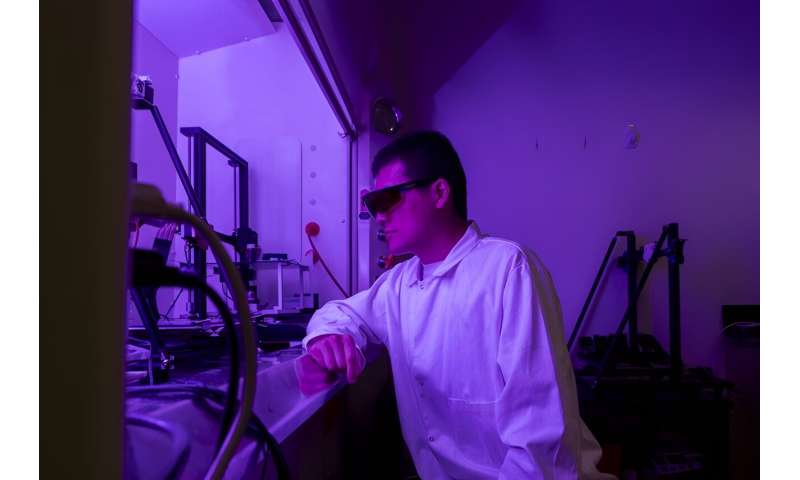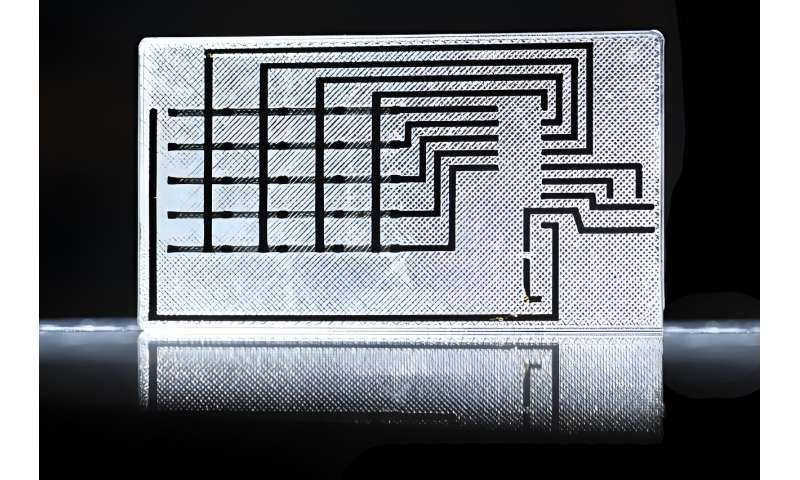Researchers at Missouri College have created a device that combines parts of traditional 3-D printing with laser generation to create multi-material, multi-functional products. Credit Score: Sam O’Keeffe
Researchers at Missouri College have developed a way to create complex devices with a single tool using a few materials, including plastics, metals and semiconductors.
Research that came out recently nature communicationA magazine outlines a 3-D printing and laser process for creating textiles with multi-material, multi-layered sensors, circuit boards or even digital elements.
This is known as the Freeform Multi-Material Meeting Process, and it is guaranteed to revolutionize the manufacturing of seamless materials.
Through printing sensors embedded inside a structure, the device can create things that can sense environmental conditions, including temperature and drive. For alternative researchers, it can be serendipitous to have a natural-looking object like a rock or seashell that can measure the speed of seawater. For the population, programs may only come with wearable units that track blood drives and optional vital indicators.
“This is the first time this type of process has been used, and it’s opening up new possibilities,” said Bujingda Zheng, a doctoral scholar in mechanical engineering at Mizzou and the study’s top author. “I’m passionate about design. I’ve always wanted to do something that no one has ever done before, and I’m going to do that here at Mizzou.”
Perhaps the most primary benefit is that innovators can focus on designing untouched goods without worrying about ways to prototype them.
“This opens up the possibility for completely new markets,” said Jian “Jeven” Lin, a master’s degree in mechanical and aerospace engineering at Mizzou. “This will have broad implications for wearable sensors, customizable robots, medical devices, and much more.”
progressive strategy
These days, producing a multilayer structure – the equivalent of a printed circuit board – is typically a cumbersome process that comes down to a few steps and supplies. Those processes are expensive, dangerous to the future, and will create waste that harms the state.
Now not only is the virgin approach better for the planet, it’s inspired by technologies that exist in nature.
“Everything in nature is made of structural and functional materials,” Zheng said. “For example, electric eels have bones and muscles that enable them to walk. They also have specialized cells that can discharge up to 500 volts to deter predators. These biological observations have provided researchers with multiple -has led to the development of new methods for fabricating 3D structures with functional applications, but other emerging methods have limitations.”
-

Doctoral scholar Bujingda Zheng uses 3-D printing and a laser process to create multi-material, multi-layered sensors, circuit forums and textiles with digital elements. Credit Score: Sam O’Keeffe
-

An example of an illuminated electrode inside a plastic material. Credit Score: Sam O’Keeffe
In particular, alternative strategies depend on how flexible the fabric will be and how small elements will be placed into high three-D buildings.
Mizzou Crew’s form uses special strategies to solve those issues. Team participants created a device that has 3 other nozzles: one delivers ink-like material, the second uses a laser to sculpt the shape and material, and the third delivers supplemental useful materials to strengthen the product’s features. Is. It starts with making a simple structure with common 3-D printing filament, which is the equivalent of polycarbonate, one of those transparent thermoplastics. Next, it switches on the laser to convert certain parts into a unique material called laser-induced graphene, and hits it exactly where it’s needed. In any case, additional supplies are added to strengthen the useful skills of the normal product.
“The I-Corps program is helping us identify market interests and needs,” Lin said. “Currently, we believe this will be of interest to other researchers, but we believe it will ultimately benefit businesses. It will help companies build device prototypes by allowing them to build prototypes in-house.” This technology, available only at Mizzou, shows great promise of changing the way products are manufactured and manufactured.”
Bujingda Zheng et al., Programmed Multimaterial Assembly via Coordinated 3-D Printing and Freeform Laser Induction, nature communication (2024). DOI: 10.1038/s41467-024-48919-5
Furnished through Missouri College
Citation:Refuse Meeting Required: Leading Edge 3D Printing Form Streamlines Multi-Material Production (2024, June 24) Accessed June 25, 2024 at https://techxplore.com/news/2024-06-required-3d-method- Content retrieved from multi-.html
This report is a matter of copyright. The Disagreement section is also reproduced without written permission, except for any dishonest behavior affecting non-public study or analysis. The content is furnished for informational purposes only.
Discover more from news2source
Subscribe to get the latest posts sent to your email.




